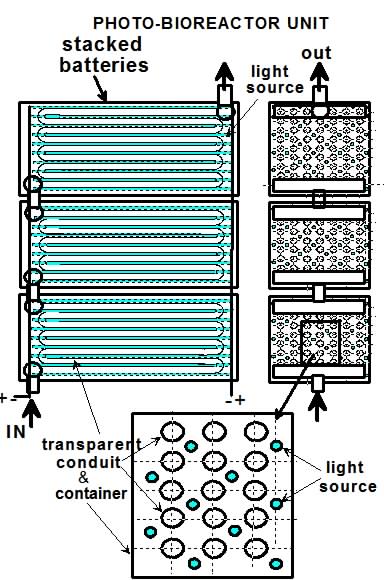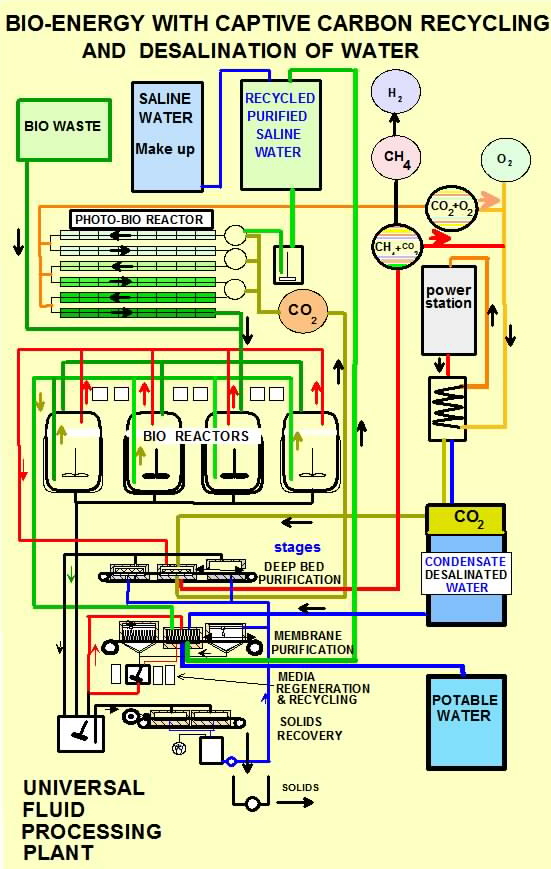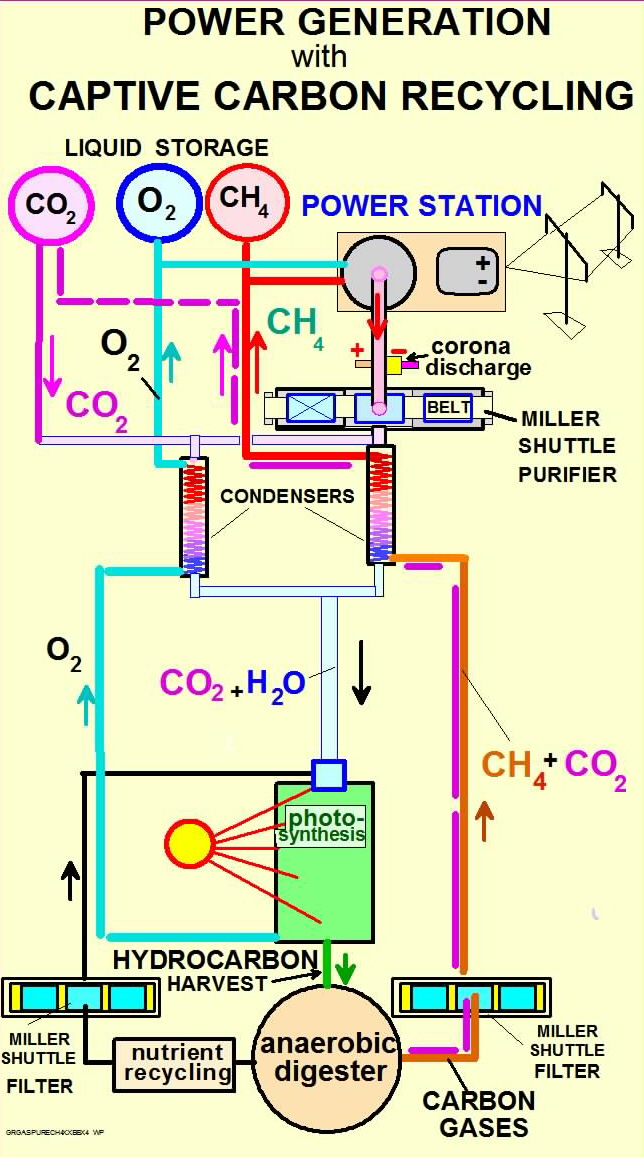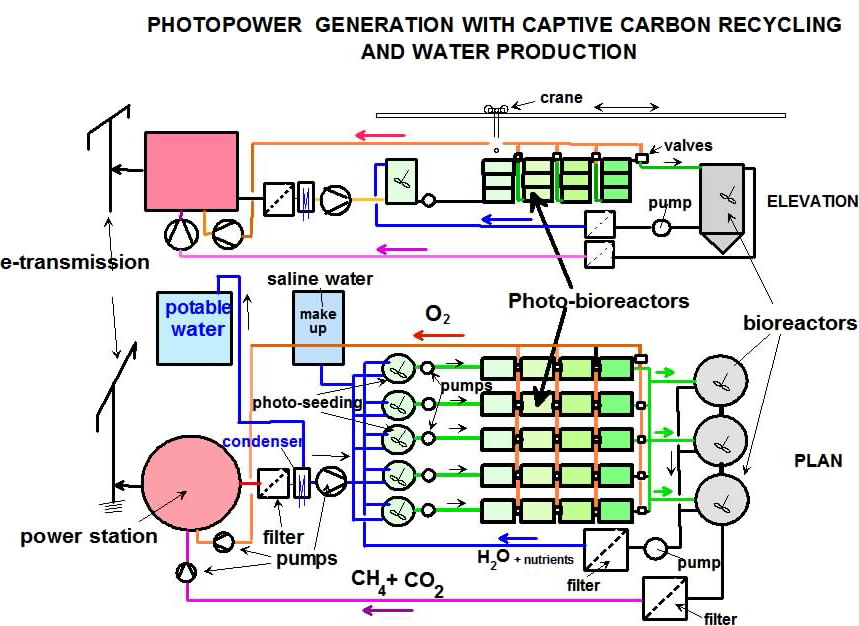CAPTIVE CARBON RECYCLING
Contents of this chapter:
The perpetuity of life on earth can only be assured by processes of recycling and reuse of today’s emitted and dumped waste in essentially closed systems.
Before the advent of mankind life on earth existed for billions of years quasi in a state of symbiotic equilibrium. Human activity has now put an end to this natural process and mankind is now in the driving seat regarding the quality of its own environment.
However, the prospect of rejecting carbon as the main source of energy for an earth covered with windmills, atom-smashing plants and photovoltaic cells is a daunting one.
Nature’s amazing feat of inventing and applying PHOTOSYNTHESIS as the source of all life and the present gigantic global NATURAL CARBON RECYCLING PROCESS can be seen as the surest way to solve and control the present global warming problem.
- Start converting existing carbon emitting power stations to CAPTIVE CARBON RECYCLING systems.
- Start realising
SELF-SUSTAINABLE CAPTIVE CARBON HUMAN SETTLEMENTS based on TOTAL RECYCLING.
The aim should be to eliminate carbon emissions from existing conventional carbon burning power stations and internal combustion engines to change the concentration of carbon dioxide in the atmosphere to a figure achieving an optimal steady-state situation. This means being in the position to throttle or increase carbon emissions at short notice on a global basis at any time according to the prevailing environmental demands.
The approach should be
TWO-PRONGED:
The rate of carbohydrate generation by photosynthesis under optimal conditions in the oceans of the world far outstrips the rates realisable on dry land with plant life. In any case land-bound plant life as a practicable alternative source of carbohydrates for energy generation with carbon neutral recycling has little chance of success.
Based on data for the photosynthesis of plankton and algae in the oceans of the world under optimal conditions
a 2000 MW power station could be maintained by harvests from 1km2 of ocean.
At present it is not practicable to harvest this production either from the oceans themselves or from equivalent “ponds” on dry land.
With the present innovation however a reduction of the ground surface area required is reduced by a factor of 20-50 whereby the operation is completely sealed and the harvesting fully automatic.
Rows of innovative sealed photo-bioreactors, stacked and interconnected, fed from pressurised
photo-seeding/sporing and carbonising apparatus deliver the harvest to bioreactors for anaerobic digestion and fermentation.
THE PLANT
Oxygen from photosynthesis is recycled to the power station together with methane and carbon dioxide evolved from the bioreactors.
Competitiveness
The conversion of existing fossil fuelled power stations to photo-synthesised methane fuelled stations offers an immediate and economical solution to the present global warming environmental problem.
A 2000 MW station fuelled by photosynthesised methane would operate in a CAPTIVE CARBON RECYCLING manner whereby gaseous and liquid emissions would be completely eliminated.
Assuming a capital investment of EURO 300 Mio for a CAPTIVE CARBON RECYCLING plant with an amortisation over 20 years the unit cost of recycled carbon with the photosynthesis system at approx. EURO 10/metric ton is extremely advantageous compared with todays fossil fuel prices.
The space requirement of the plant would be of the order of 5 hektars.
Transparent tubes are preferably arranged in serpentine fashion with common input and output manifolds. Transparent housing allows all round access of sunlight.
Internal artificial sources of light are also provided.
Specifically designed for obtaining the maximum exposure to light of liquid surface, the space occupied by a typical MILLER PHOTO-BIOREACTOR UNIT has dimensions:
L = 2m, H = 3m, B = 1m

A feature of the design is the ease of removal of the individual layers of the batteries for maintenance.
They are designed for both indoor and outdoor installation.
The versatility of the MILLER CAPTIVE CARBON RECYCLING SYSTEM is illustrated on the left.
In addition to energy from PHOTOSYNTHESISED BIOMASS with carbon recycling, BIOWASTE from human settlements and concomitant animal husbandry, horticulture and arable crops is also bio-processed to carbonaceous fuel-gas for recycling.
Essential to these processes is the integrated MILLER UNIVERSAL FLUID PROCESSING PLANT by means of which all gaseous and liquid streams are purified and converted to alternative end-products such as HYDROGEN, ALCOHOL and a variety of PHOTO-CHEMICALS.
The possibility of DESALINATION paves the way for selfsustainable settlements in previously uninhabitable areas of the planet.



